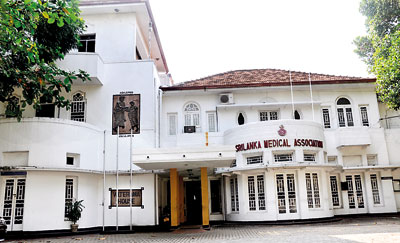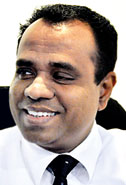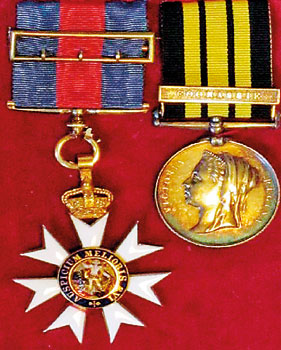Kynsey and Wijerama……two sets of footprints buried in the sands of time, but time has not been able to obliterate the work they have left behind.
For the squat, solid building on Wijerama Mawatha, Colombo 7, stands testimony not only to the initiative of a Britisher but also the dedication and philanthropy of a Ceylonese.
This is what has ensured that the medical profession would move from strength to strength and allowed it to be justifiably proud at having in the Sri Lanka Medical Association (SLMA), the oldest national medical association in all of Asia and Australasia. The beginnings, however, were humble way back in 1887.
The Surgeon-Captain in the Army Medical Department and Principal Medical Officer Dr. William R. Kynsey, who was to become Sir William later, "persuaded" 15 doctors to meet on February 26, 1887 at the Colonial Medical Library on Maradana Road. Incidentally, it is also believed that he later became the Chief Superintendent of Police and a member of the Legislative Council. His name adorns a road (Kynsey Road) off which still lies the medical hub of Colombo, the National Hospital, the De Soysa Hospital for Women, the Cardiology Institute and the Medical Faculty.
 |
| The building of the SLMA and medal (below) worn by the SLMA President
since the inception of the association |
|
In calling for the meeting, Dr. Kynsey was bent on launching the Ceylon Branch of the British Medical Association. Although he was the "moving force", as is recorded in the yellowed and dog-eared pages of books treasured at the SLMA, he did not take up the post of President as he was going abroad on furlough, when it was finally formed on December 17, the same year. Instead, it fell on Dr. P.D. Anthoniz to head the fledgling association with a membership of 65.
As the SLMA celebrates its 125th anniversary, its current President, Prof. Vajira H.W. Dissanayake, one in a line of eminent doctors who have steered its destiny, hastens to add that "we must not fail to go back in history another 200 years to the 17th century, 1681, Dutch Hospital in Fort, the oldest hospital of the Western Medical era of the country".
Explaining the need for the Ceylon Branch of the British Medical Association, Dr. C.G. Uragoda in his book, 'A history of medicine in Sri Lanka' states that with the progressive increase in the number of doctors a century ago, the need to establish an association to serve as a common platform for the profession was felt. "Doctors, for example, did not have a forum for the exchange of professional knowledge. There is an instance where a doctor, due to the lack of such a medical association, was obliged to present a case report before the Ceylon Branch of the Royal Asiatic Society!"
(It had been in 1981 that Dr. Uragoda along with Dr. Dennis Aloysius sifted through the reams of paper and journals to trace the history of the SLMA.)
Dr. Kynsey had proposed as the objective of the branch "to bring the profession together, to facilitate investigation into matters of professional interest and to promote discussion". Later the matter had been taken up at a meeting of the British Medical Association in April 1887 and approved, with the Ceylon Branch being formally inaugurated on December 17, 1887, with 19 members attending from Colombo, Kandy, Galle and Kalutara.
By 1898, the membership of the Ceylon Branch had swelled to 113, with every member being entitled to his personal copy of the British Medical Journal.
Gradually, with the colonial era drawing to a close, a name-change to Ceylon Medical Association had occurred in 1951, with the umbilical cord with the parent body being cut in 1957. When Sri Lanka took on the Republican Constitution, the second baptism had taken place with the name being changed to the Sri Lanka Medical Association.
Interesting nuggets of information emerge about the early days of the Ceylon Branch. It had played host to the parent body on the return journey of its members from the annual meeting held in Australia in 1935. Greeting them at the pier, for they travelled by ship, the office-bearers of the Ceylon Branch, President-elect for 1936, Dr. J.R. Blaze, Vice Presidents Dr. H.M. Peries and Dr. Frank Gunasekera, Secretary and Treasurer Dr. P.B. Fernando and members of the council, Dr. Nicholas Attygalle, Dr. J.H.F. Jayasuriya and Dr. P.C.C. de Silva, had taken them around the places of interest in the city. Later they had been entertained to refreshments at Queen's House.
While many have played a major role in guiding the SLMA, a key figure had been Dr. E.M. Wijerama, Consultant Physician at the General Hospital, Colombo, described as "an excellent clinician, able teacher and erudite medical historian".
Without a home of its own, the SLMA had spent 73 years at the Colonial Library and four more at the Consultants' Lounge of the Colombo General Hospital before finding a permanent abode in 1964 in the residence of Dr. Wijerama down McCarthy Road.
The donation had brought him an "accolade" in the form of McCarthy Road being renamed Wijerama Mawatha, a signal honour bestowed upon very few men while they were still alive.
Details minuted in its records bring to light the vibrancy of the SLMA. A resolution on August 17, 1949, by Dr. Mary Rutnam who had been a member for 50 years, that conception control should be part of the activities of public health and instruction in control methods should be part of the curriculum of the Colombo Medical College, the only medical school in Sri Lanka at that time, had faced a resounding defeat, says current President Prof. Dissanayake flipping back the pages of time, while pointing out the need for the SLMA to be relevant in the modern context. "It would be hard to imagine such a resolution being defeated today."
 |
| Prof. Dissanayake:The current President. Pix by Susantha Liyanawatte |
Then on October 9, 1956, when the Government Medical Officers' Association (GMOA) organized the first doctors' strike, the Medical Association had sent a resolution to then Prime Minister S.W.R.D. Bandaranaike that "this council is in sympathy with the demand of the GMOA for better salaries and conditions of service to doctors and for the abolition of private practice!"
"I don't think the abolition of private practice would meet with much fervour today," quips Prof. Dissanayake.
The SLMA has also not been without its ups and downs. Shock waves had rippled through the association on August 20, 1952 with the then President Dr. A.S. Rajasingham resigning, the first and only such resignation, as some resolutions presented by him had been defeated.
The first had been a resolution to felicitate the newly-appointed Health Minister of the time, indicating the apolitical nature of the association, while the second had dealt with the amalgamation of ayurveda and western medicine. After the defeats, he had withdrawn the third resolution, resigning six days later, leading to the “acrimonious” assumption of office by his successor.
Fifty-nine years later, the formation of the Herbal Medicine Committee in the SLMA last year by Prof. S.P. Lamabadasuriya did not lead to such dramas says Prof. Dissanayake, pointing out that ancient Sri Lanka boasts of the Mihintale hospital dating back to the 5th century BC, 400 years before any other hospital anywhere else in the world.
Citing its unique feature, in that any qualified doctor be it a lowly junior or a mighty consultant, can be a member, Prof. Dissanayake explains that it is important for doctors to provide a service in a professional manner and also conduct themselves ethically, especially as they work with people.
Evolving over the years, the 3,000-strong SLMA with a strong Code of Conduct has proven that every profession needs to have a professional association to guide it.
Lecture today
A former President of the SLMA, Dr. Dennis Aloysius will deliver a lecture titled 'A short history of the Sri Lanka Medical Association' today at 6 p.m. at the Lionel Memorial Auditorium of the Sri Lanka Medical Association at Wijerama House, 6 Wijerama Mawatha, Colombo 7 to mark the 125th anniversary of this august body. |




